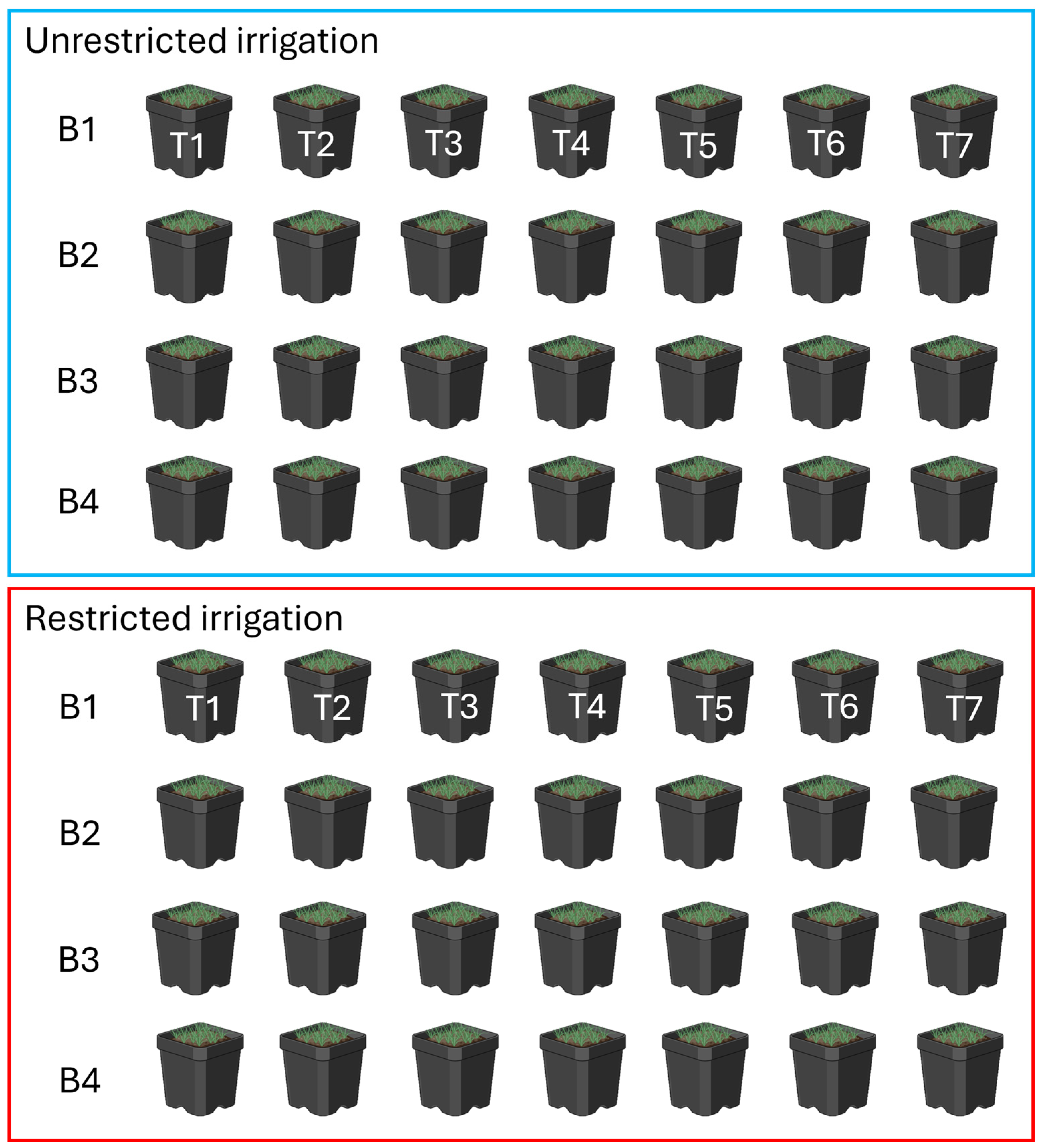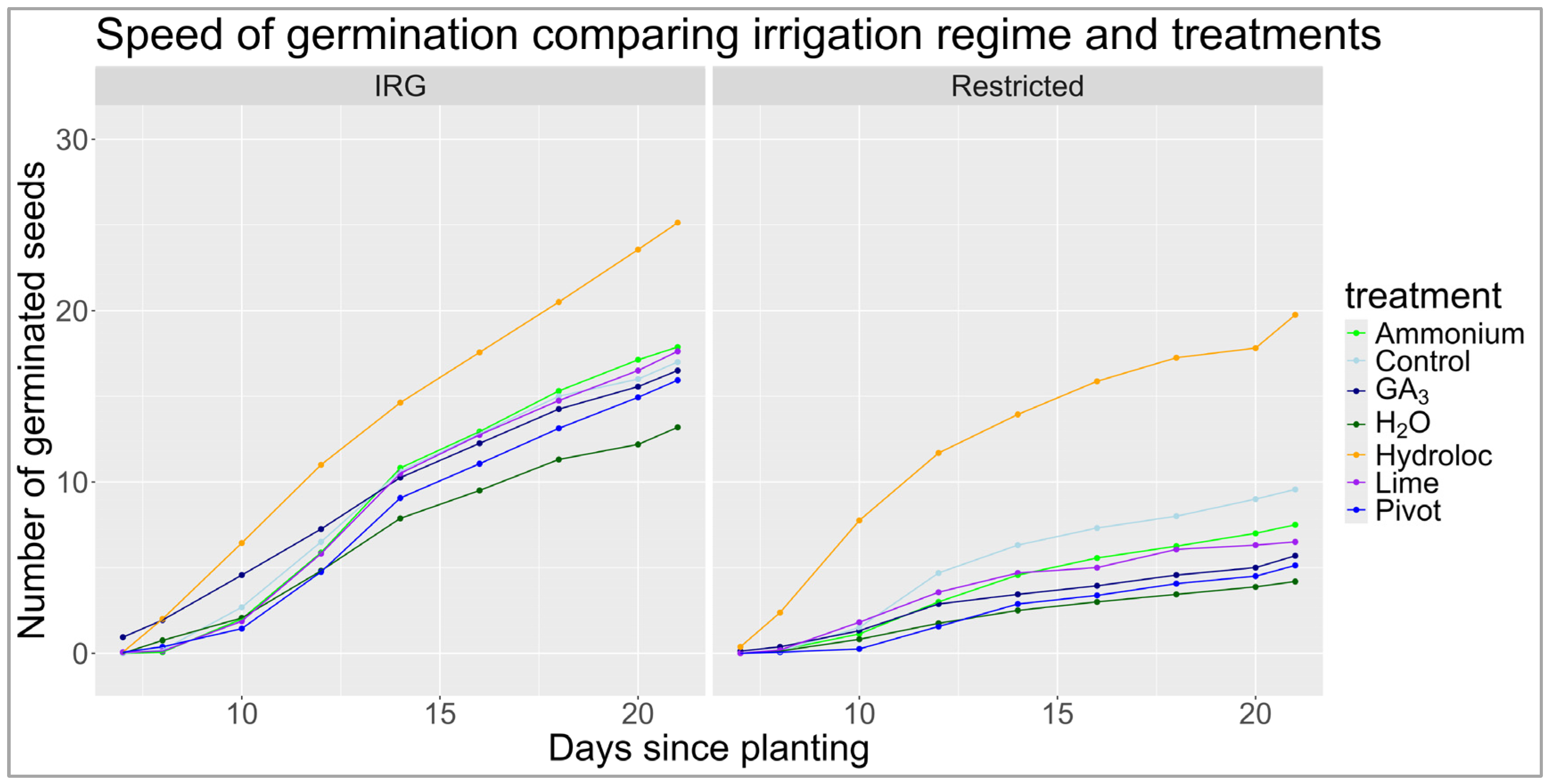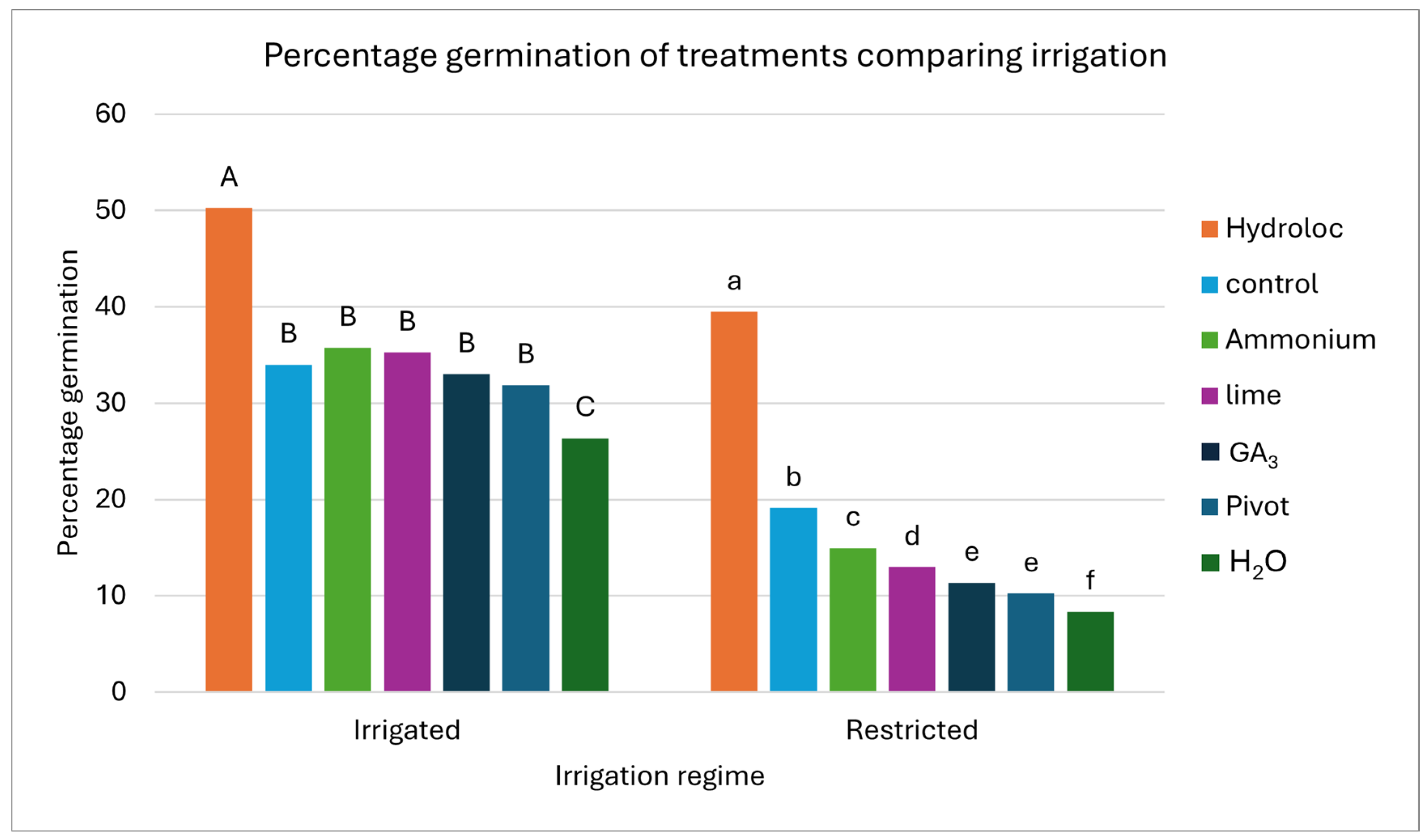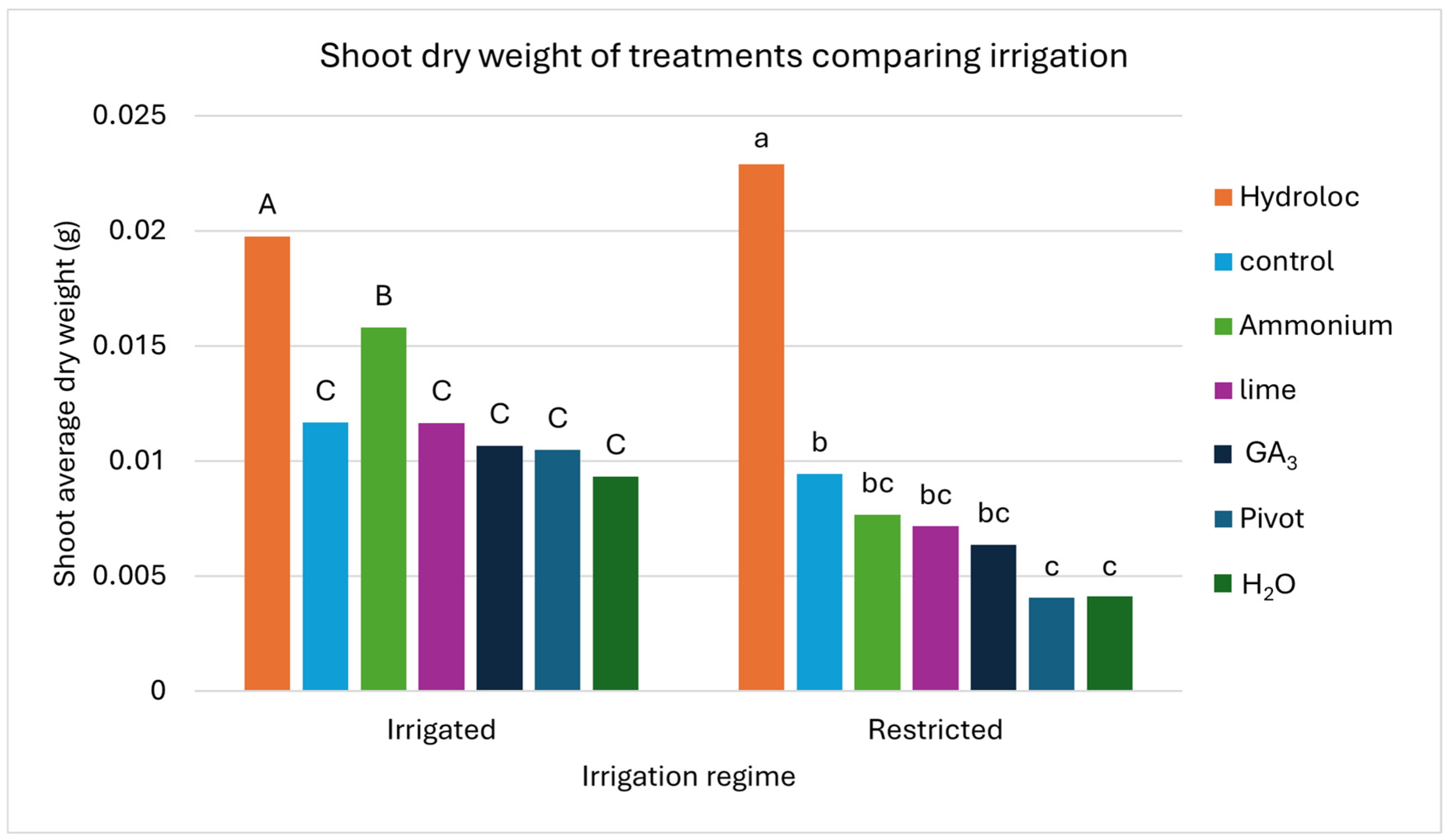Investigating Seed Treatments and Soil Amendments to Improve the Establishment of Kentucky Bluegrass as a Perennial Groundcover
Abstract
1. Introduction
2. Materials and Methods
2.1. Restricted Irrigation Regime
2.2. Unrestricted Irrigation Regime
2.3. Seed Germination Testing
2.4. Seed Coatings/Treatments
2.5. Measurements
2.6. Statistical Analysis
- µ = Germination mean;
- Pj = Effect of period on germination;
- B(P)jk = Effect of block in period on germination;
- Il = Effect of irrigation on germination;
- Tm = Effect of treatment on germination;
- Ƹjklm = Error term.
3. Results
3.1. Speed of Germination
3.2. Percentage Seed Germination
3.3. Shoot Dry Weight
4. Discussion
4.1. Hydroloc and Lime
4.2. Nitrogen
4.3. Seed Priming
5. Conclusions
Supplementary Materials
Author Contributions
Funding
Data Availability Statement
Conflicts of Interest
References
- Comer, P.J.; Hak, J.C.; Kindscher, K.; Muldavin, E.; Singhurst, J. Continent-Scale Landscape Conservation Design for Temperate Grasslands of the Great Plains and Chihuahuan Desert. Nat. Areas J. 2018, 38, 196–211. [Google Scholar] [CrossRef]
- U.S. Department of Agriculture. Summary Report: 2017 National Resources Inventory; Center for Survey Statistics and Methodology, Iowa State University: Ames, IA, USA; Natural Resources Conservation Service: Washington, DC, USA, 2020.
- Moore, K.J.; Karlen, D.L. Double Cropping Opportunities for Biomass Crops in the North Central USA. Biofuels 2013, 4, 605–615. [Google Scholar] [CrossRef]
- Hall, J.K.; Hartwig, N.L.; Hoffman, L.D. Cyanazine Losses in Runoff from No-Tillage Corn in “Living” and Dead Mulches vs. Unmulched, Conventional Tillage. J. Environ. Qual. 1984, 13, 105–110. [Google Scholar] [CrossRef]
- Moore, K.J.; Anex, R.P.; Elobeid, A.E.; Fei, S.; Flora, C.B.; Goggi, A.S.; Jacobs, K.L.; Jha, P.; Kaleita, A.L.; Karlen, D.L.; et al. Regenerating Agricultural Landscapes with Perennial Groundcover for Intensive Crop Production. Agronomy 2019, 9, 458. [Google Scholar] [CrossRef]
- Flynn, E.S.; Moore, K.J.; Singer, J.W.; Lamkey, K.R. Evaluation of Grass and Legume Species as Perennial Ground Covers in Corn Production. Crop Sci. 2013, 53, 611–620. [Google Scholar] [CrossRef]
- Schlautman, B.; Bartel, C.; Diaz-Garcia, L.; Fei, S.; Flynn, S.; Haramoto, E.; Moore, K.; Raman, D.R. Perennial Groundcovers: An Emerging Technology for Soil Conservation and the Sustainable Intensification of Agriculture. Emerg. Top. Life Sci. 2021, 5, 337–347. [Google Scholar]
- Bartel, C.A.; Archontoulis, S.V.; Lenssen, A.W.; Moore, K.J.; Huber, I.L.; Laird, D.A.; Dixon, P.M. Modeling Perennial Groundcover Effects on Annual Maize Grain Crop Growth with the Agricultural Production Systems sIMulator. Agron. J. 2020, 112, 1895–1910. [Google Scholar] [CrossRef]
- Qian, Y.; Follett, R.F.; Kimble, J.M. Soil Organic Carbon Input from Urban Turfgrasses. Soil Sci. Soc. Am. J. 2010, 74, 366–371. [Google Scholar] [CrossRef]
- Beard, J.B. Turfgrass: Science and Culture; Prentice-Hall: Englewood Cliffs, NJ, USA, 1972; ISBN 0-13-933002-X. [Google Scholar]
- Chen, A.; Fei, S.-Z.; Lenssen, A.W.; Moore, K.J. Evaluating Cool-season Grass Species as Potential Perennial Groundcover for Maize Production. Agron. J. 2022, 114, 2415–2429. [Google Scholar] [CrossRef]
- Bartel, C.A.; Banik, C.; Lenssen, A.W.; Moore, K.J.; Laird, D.A.; Archontoulis, S.V.; Lamkey, K.R. Establishment of Perennial Groundcovers for Maize-Based Bioenergy Production Systems. Agron. J. 2017, 109, 822–835. [Google Scholar] [CrossRef]
- Campbell, J.H.; Henderson, J.J.; Inguagiato, J.C.; Wallace, V.H.; Minniti, A. Optimizing Pre-Germination Techniques for Kentucky Bluegrass and Perennial Ryegrass. J. Environ. Hortic. 2019, 37, 19–23. [Google Scholar] [CrossRef]
- Gupta, R.; Chakrabarty, S.K. Gibberellic Acid in Plant: Still a Mystery Unresolved. Plant Signal. Behav. 2013, 8, e25504. [Google Scholar] [CrossRef]
- Nelson, M.N.; Nesi, N.; Barrero, J.M.; Fletcher, A.L.; Greaves, I.K.; Hughes, T.; Laperche, A.; Snowdon, R.; Rebetzke, G.J.; Kirkegaard, J.A. Chapter Two—Strategies to Improve Field Establishment of Canola: A Review. In Advances in Agronomy; Sparks, D.L., Ed.; Academic Press: Cambridge, MA, USA, 2022; Volume 175, pp. 133–177. ISBN 0065-2113. [Google Scholar]
- Hathcock, A.L.; Dernoeden, P.H.; Turner, T.R.; McIntosh, M.S. Tall Fescue and Kentucky Bluegrass Response to Fertilizer and Lime Seed Coatings. Agron. J. 1984, 76, 879–883. [Google Scholar] [CrossRef]
- Leinauer, B.; Serena, M.; Singh, D. Seed Coating and Seeding Rate Effects on Turfgrass Germination and Establishment. HortTechnology Hortte 2010, 20, 179–185. [Google Scholar] [CrossRef]
- Richardson, M.D.; Hignight, K.W. Seedling Emergence of Tall Fescue and Kentucky Bluegrass, as Affected by Two Seed Coating Techniques. HortTechnology Hortte 2010, 20, 415–417. [Google Scholar] [CrossRef]
- United Nations Department of Economic and Social Affairs. The Sustainable Development Goals Report 2024; United Nations: New York, NY, USA, 2024; ISBN 978-92-1-358975-5. [Google Scholar]
- Bartel, C.A.; Jacobs, K.L.; Moore, K.J.; Raman, D.R. Anticipatory Technoeconomic Evaluation of Kentucky Bluegrass-Based Perennial Groundcover Implementations in Large-Scale Midwestern US Corn Production Systems. Sustainability 2024, 16, 7112. [Google Scholar] [CrossRef]
- Virgin, H.I. Light-Induced Unfolding of the Grass Leaf. Physiol. Plant. 1962, 15, 380–389. [Google Scholar] [CrossRef]
- Assn of Official Seed. AOSA Rules For Testing Seeds: Principles and Procedures, Effective October 1, 2019; Assn of Official Seed: Wichita, KS, USA, 2019. [Google Scholar]
- Curell, C. Why Is Soil Water Holding Capacity Important? Available online: https://www.canr.msu.edu/news/why_is_soil_water_holding_capacity_important (accessed on 28 October 2024).
- Vazquez, E.; Benito, M.; Espejo, R.; Teutscherova, N. Effects of No-Tillage and Liming Amendment Combination on Soil Carbon and Nitrogen Mineralization. Eur. J. Soil Biol. 2019, 93, 103090. [Google Scholar] [CrossRef]
- Abdullah, B.S.; Abdulrahman, Y.A. Effect of Different Concentrations of Gibberellic Acid on Seeds Germination and Growth in Different Turf Grass Genera. Kufa J. Agric. Sci. 2017, 9, 226–247. [Google Scholar]
- SAS Institute Inc. SAS/STAT® 9.4 User’s Guide; SAS Institute Inc.: Cary, NC, USA, 2013. [Google Scholar]
- Folck, A.J.; Bigelow, C.A.; Jiang, Y.; Patton, A.J. Genotypic Variation in Germination Rate, Seedling Vigor, and Seed Phenotype of Kentucky Bluegrass Cultivars. Crop Sci. 2023, 63, 3065–3078. [Google Scholar] [CrossRef]
- Larsen, S.U.; Andreasen, C.; Kristoffersen, P. The Variation in Seed Weight within and among Cultivars of Slender Creeping Red Fescue (Festuca rubra ssp. litoralis), Perennial Ryegrass (Lolium perenne) and Kentucky Bluegrass (Poa pratensis) and Its Importance for the Composition of Seed Mixtures. Seed Sci. Technol. 2004, 32, 135–147. [Google Scholar] [CrossRef]
- Ma, H.-Y.; Zhao, D.-D.; Ning, Q.-R.; Wei, J.-P.; Li, Y.; Wang, M.-M.; Liu, X.-L.; Jiang, C.-J.; Liang, Z.-W. A Multi-Year Beneficial Effect of Seed Priming with Gibberellic Acid-3 (GA3) on Plant Growth and Production in a Perennial Grass, Leymus Chinensis. Sci. Rep. 2018, 8, 13214. [Google Scholar] [CrossRef] [PubMed]
- Norton, M.R. The Effect of Lime Application to an Acid Soil on Perennial Grass Establishment; NSW Department of Primary Industries: Canberra, Australia, 2010. [Google Scholar]
- Bethke, P.C.; Libourel, I.G.L.; Jones, R.L. Nitric Oxide Reduces Seed Dormancy in Arabidopsis. J. Exp. Bot. 2006, 57, 517–526. [Google Scholar] [CrossRef]
- Monaco, T.A.; Mackown, C.T.; Johnson, D.A.; Jones, T.A.; Norton, M.; Norton, J.B.; Redinbaugh, M.G. Nitrogen Effects on Seed Germination and Seedling Growth. J. Range Manag. 2003, 56, 646–653. [Google Scholar] [CrossRef]
- Zhang, T.; Liu, M.; Huang, X.; Hu, W.; Qiao, N.; Song, H.; Zhang, B.; Zhang, R.; Yang, Z.; Liu, Y.; et al. Direct Effects of Nitrogen Addition on Seed Germination of Eight Semi-arid Grassland Species. Ecol. Evol. 2020, 10, 8793–8800. [Google Scholar] [CrossRef]
- Davis, A.S. Nitrogen Fertilizer and Crop Residue Effects on Seed Mortality and Germination of Eight Annual Weed Species. Weed Sci. 2007, 55, 123–128. [Google Scholar] [CrossRef]
- Graham, P.H.; Vance, C.P. Legumes: Importance and Constraints to Greater Use. Plant Physiol. 2003, 131, 872–877. [Google Scholar] [CrossRef]
- Bhattacharjee, R.B.; Singh, A.; Mukhopadhyay, S.N. Use of Nitrogen-Fixing Bacteria as Biofertiliser for Non-Legumes: Prospects and Challenges. Appl. Microbiol. Biotechnol. 2008, 80, 199–209. [Google Scholar] [CrossRef]
- Davis, W.G.; Bonini Pires, C.A.; Ruiz Diaz, D.A.; Roozeboom, K.L.; Rice, C.W. Pivot Bio Proven Inoculant as a Source of Nitrogen in Corn. Kans. Agric. Exp. Stn. Res. Rep. 2020, 6, 7. [Google Scholar] [CrossRef]
- O’Callaghan, M. Microbial Inoculation of Seed for Improved Crop Performance: Issues and Opportunities. Appl. Microbiol. Biotechnol. 2016, 100, 5729–5746. [Google Scholar] [CrossRef]
- Lutts, S.; Benincasa, P.; Wojtyla, L.; Kubala, S.; Pace, R.; Lechowska, K.; Quinet, M.; Garnczarska, M. Seed Priming: New Comprehensive Approaches for an Old Empirical Technique. In New Challenges in Seed Biology-Basic and Translational Research Driving Seed Technology; InTechOpen: London, UK, 2016; Volume 46. [Google Scholar]
- El-Tohamy, W.A.; Dasgan, H.Y.; Gruda, N.S. Impact of Gibberellic Acid on Water Status, Growth, and Development of Cape Gooseberry in Newly Reclaimed Sandy Lands within Arid Regions. Horticulturae 2023, 9, 1283. [Google Scholar] [CrossRef]
- Maggio, A.; Barbieri, G.; Raimondi, G.; De Pascale, S. Contrasting Effects of GA3 Treatments on Tomato Plants Exposed to Increasing Salinity. J. Plant Growth Regul. 2010, 29, 63–72. [Google Scholar] [CrossRef]
- Gubler, F.; Millar, A.A.; Jacobsen, J.V. Dormancy Release, ABA and Pre-Harvest Sprouting. Curr. Opin. Plant Biol. 2005, 8, 183–187. [Google Scholar] [CrossRef]
- Liu, X.; Hou, X. Antagonistic Regulation of ABA and GA in Metabolism and Signaling Pathways. Front. Plant Sci. 2018, 9, 251. [Google Scholar] [CrossRef]
- Gubler, F.; Chandler, P.M.; White, R.G.; Llewellyn, D.J.; Jacobsen, J.V. Gibberellin Signaling in Barley Aleurone Cells. Control of SLN1 and GAMYB Expression. Plant Physiol. 2002, 129, 191–200. [Google Scholar] [CrossRef]
- Bewley, J.D.; Black, M.; Halmer, P. The Encyclopedia of Seeds: Science, Technology and Uses; Cabi: Oxfordshire, UK, 2006. [Google Scholar]
- Magan, N.; Sanchis, V.; Aldred, D. The Role of Spoilage Fungi in Seed Deterioration. Mycol. Ser. 2004, 21, 311–324. [Google Scholar]
- Cj, V.; Nethra, N. Seed Deterioration: An Overview. Seed Res. 2022, 50, 91–99. [Google Scholar]





| Source | DF | Sum of Squares | Mean Square | F Value | p Value |
|---|---|---|---|---|---|
| Period | 3 | 3208.91 | 1069.64 | 11.52 | <0.0001 |
| Block (period) | 12 | 812.79 | 67.73 | 0.73 | 0.7215 |
| Irrigation | 1 | 19,277.16 | 19,277.16 | 207.59 | <0.0001 |
| Block × Irrigation (period) | 15 | 1099.70 | 73.31 | 0.79 | 0.6883 |
| Treatment | 6 | 15,160.50 | 2526.75 | 27.21 | <0.0001 |
| Irrigation × Treatment | 6 | 896.71 | 149.45 | 1.61 | 0.1469 |
| Residual error | 43 | 40,455.77 | 940.83 | 10.13 | <0.0001 |
| Source | DF | Sum of Squares | Mean Square | F Value | p Value |
|---|---|---|---|---|---|
| Period | 3 | 0.00085 | 0.00028 | 9.68 | <0.0001 |
| Block (period) | 12 | 0.00041 | 0.00003 | 1.16 | 0.3168 |
| Irrigation | 1 | 0.00087 | 0.00087 | 29.86 | <0.0001 |
| Block × Irrigation (period) | 15 | 0.00218 | 0.00015 | 4.96 | <0.0001 |
| Treatment | 6 | 0.00474 | 0.00079 | 26.97 | <0.0001 |
| Irrigation × Treatment | 6 | 0.00063 | 0.00010 | 3.58 | 0.0023 |
| Residual error | 43 | 0.00967 | 0.00022 | 7.68 | <0.0001 |
Disclaimer/Publisher’s Note: The statements, opinions and data contained in all publications are solely those of the individual author(s) and contributor(s) and not of MDPI and/or the editor(s). MDPI and/or the editor(s) disclaim responsibility for any injury to people or property resulting from any ideas, methods, instructions or products referred to in the content. |
© 2025 by the authors. Licensee MDPI, Basel, Switzerland. This article is an open access article distributed under the terms and conditions of the Creative Commons Attribution (CC BY) license (https://creativecommons.org/licenses/by/4.0/).
Share and Cite
Moran, J.; Goggi, A.S.; Moore, K.J.; Fei, S.-z. Investigating Seed Treatments and Soil Amendments to Improve the Establishment of Kentucky Bluegrass as a Perennial Groundcover. Seeds 2025, 4, 16. https://doi.org/10.3390/seeds4010016
Moran J, Goggi AS, Moore KJ, Fei S-z. Investigating Seed Treatments and Soil Amendments to Improve the Establishment of Kentucky Bluegrass as a Perennial Groundcover. Seeds. 2025; 4(1):16. https://doi.org/10.3390/seeds4010016
Chicago/Turabian StyleMoran, Jack, A. Susana Goggi, Ken J. Moore, and Shui-zhang Fei. 2025. "Investigating Seed Treatments and Soil Amendments to Improve the Establishment of Kentucky Bluegrass as a Perennial Groundcover" Seeds 4, no. 1: 16. https://doi.org/10.3390/seeds4010016
APA StyleMoran, J., Goggi, A. S., Moore, K. J., & Fei, S.-z. (2025). Investigating Seed Treatments and Soil Amendments to Improve the Establishment of Kentucky Bluegrass as a Perennial Groundcover. Seeds, 4(1), 16. https://doi.org/10.3390/seeds4010016








